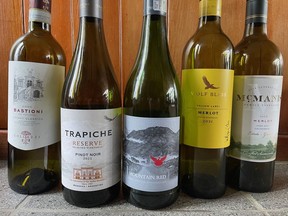Good Drink: Sugar levels in red table wines

Article content
I worked a private tasting event recently and the conversation came around to sweetened red table wines. This unofficial category, led by the infamous Apothic line of red wines from Gallo, has gradually increased in number over the past decade. Essentially, the producers figured out that some people will pay $20-30 for a basic red wine that has been sweetened to over 15 grams/litre, sometimes in the high 20s, which, combined with heavy use of toasty oak, makes for a very unbalanced wine drinking experience.
To put this in perspective, this is way less sugar than is in a Red Bull or a regular Coke, and let’s not even talk about Mountain Dew.
The problem is that they are too sweet to match with most foods where you would typically drink red wine (lamb, beef, duck), but they are not sweet enough to be a true dessert wine, which must be sweeter than the dessert, else the wine tastes bitter/sour. They are all vanilla, mocha coffee, and spice, alongside sweet berry fruit. Other brands in the category include Meomi Pinot Noir, Menage a Trois, and Cupcake Merlot. They are really only good for sipping on their own.
Now, you should understand that these are not poorly made wines. They are clean and well made. They are everything they were intended to be, which is introductory wine for people who find dry red wine tannins hard to take. If you have a sweet tooth and like a lot of sugar in your coffee, these might appeal. The real problem writers and Somms have with them is that they do not reflect terroir, and some are priced far too high for a basic beginner sipper.
I recently found an Apothic Merlot in my wine rack. Not sure how it got there. I decided to judge it fairly, so I blind tasted it against two other $20 new world Merlots: Wolf Blass from Australia and McManis from California. Side note: I hadn’t noticed before, but the Merlot category has really dried up at ANBL. Remember when they were a thing?
The results were not surprising. Both the Wolf Blass and McManis were nice, plummy reds with good varietal character and not too much oak. They were essentially dry and would be really good with a steak. The Apothic, however, stuck out like a sore thumb (overripe plum?). It smelled of coffee and cloves, and was so sweet in comparison that I couldn’t drink the bottle. I didn’t even use it for cooking as those flavours would dominate anything. The best use would be for mulled wine.
In any case, don’t feel shame if you enjoy wines like these. They have their place in the market. But just be aware that you can pay far less for a nice basic red that has ripe red fruit, and smooth tannins, but is dry. There are dozens at the ANBL.
Here are five red table wines that aren’t too sugary sweet, including the two that I used to compare to the sweet Merlot, plus two bone-dry classic reds:
5. Collazzi Bastioni Chianti Classico, 2020, DOCG,Italy, $29.99 (splurgeworthy), PC: 8007425200574
This is old school, high quality Chianti Classico, Classico being the sub region of Chianti where many of the best wineries are located. It has savoury, cherry fruit, good structure, and a dry, moderately tannic finish. Perfect for pizza or other tomato based Italian specialties. It can age, too.
Sommelier’s Tip: This 2020 is drinking nicely but I’d enjoy it even more with another 3-5 years of cellaring.
4. Wolf Blass Yellow Label Merlot, 2021, South Australia, $19.99, PC 098137668682
A smooth red featuring plum fruit, judiciously supported by oak. Medium bodied, the finish is dry with good balancing acidity. Fairly straightforward, but good.
Sommelier’s Tip: A good house red, nice for anything from chili to burgers, steak or even roast chicken.
3. McManis Merlot, 2020, Lodi AVA, $23.99, PC 670580002178
Slightly more premium, this is quite similar to the Wolf Blass in terms of the fruit character, but with a touch more body and oak influence. Still, it is dry and balanced, and satisfying.
Sommelier’s Tip: I’d drink this with a grilled beef tenderloin with a red wine sauce.
2. Trapiche Pinot Noir, Reserve, 2021, Mendoza, Argentina, $18.49, PC 7790240021608
A great example of a juicy, somewhat oaky crowd pleaser of a Pinot for under $20. Because of the low tannins, I think this would appeal to the same people who drink Meomi, except this is much cheaper and drier (lower calories). It has ripe cherry flavours, medium body, and a soft finish.
Sommelier’s Tip: Chill slightly, and serve with burgers or grilled salmon.
1. Thelema Mountain Red, WO Western Cape, South Africa, e, $17.99, PC 3172258001362
Here we have a nicely balanced but very fruity and somewhat oaky red for a very fair price. A blend of 37% Shiraz – 25% Petit Verdot – 23% Cabernet Sauvignon – 10% Merlot – 5% Grenache, Mountain Red is spicy, fruity, with a ropund texture and a smooth finish. It is also DRY.
Sommelier’s Tip: Great with BBQ ribs.
Cheers!
Craig
Craig Pinhey is a Sommelier and freelance writer. Check out his FB page: www.facebook.com/craig.pinhey or follow on Twitter @frogspadca or Instagram @brufrog












Postmedia is committed to maintaining a lively but civil forum for discussion. Please keep comments relevant and respectful. Comments may take up to an hour to appear on the site. You will receive an email if there is a reply to your comment, an update to a thread you follow or if a user you follow comments. Visit our Community Guidelines for more information.